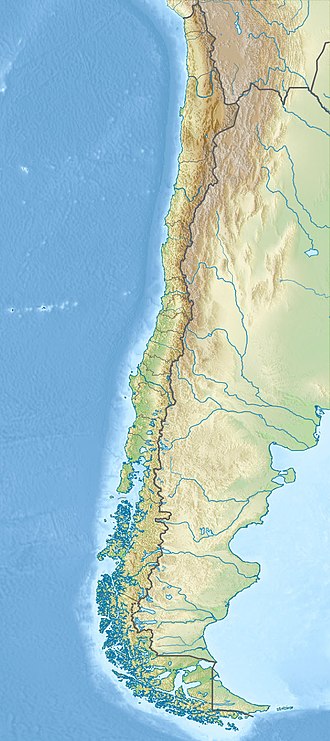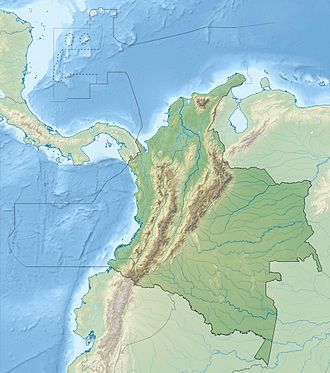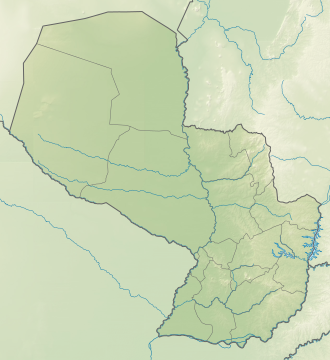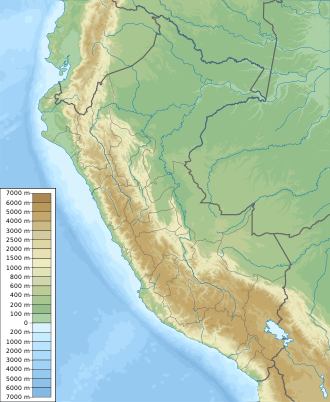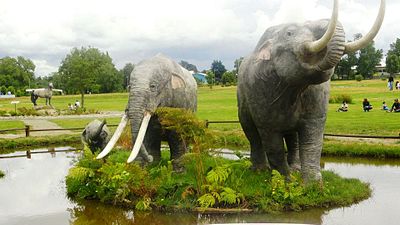User:Tisquesusa/sandbox/South American gomphotheres
This is a list of gomphothere fossils found in South America. Gomphotheres were elephant-like mammals that lived from the Middle Miocene (approximately 12 million years ago) to the Holocene (6000 years BP).
The following species have been described in twentieth and twenty-first century paleontological literature about South America.[1] An alternative proposal is considered within the scientific community,[2][3][4][5] listed below.
Original classification
- Gomphotheriidae
- Cuvieroniinae
- Cuvieronius (Osborn 1923)
- C. arellanoi (Ochoterena & Silva 1970)
- C. hyodon (=C. humboldti) (Fischer 1814) (type)
- C. priestleyi (Hay & Cook 1930)
- C. tarijensis (Cabrera 1929)
- C. tropicus (Cope 1884) (=C. oligobunis (Cope 1893))
- Haplomastodon (Hoffstetter 1950)
- H. chimborazi (Proaño 1922)
- H. guayasensis (Hoffstetter 1952)
- H. waringi (Holland 1920) (type)
- Notiomastodon (Cabrera 1929)
- N. ornatus (=S. platensis)
- N. platensis (Mothé et al. 2012) (type)
- N. vidali (Castellanos 1948)
- Stegomastodon (Pohlig 1912)
- S. mirificus (Leidy 1858) (= "S. successor, S. arizonae, S. texanus") (type)
- S. platensis (Ameghino 1888)
- S. primitivus (Osborn 1936) (=S. rexroadensis)
- S. superbus (Casamiguela et al. 1996)
- S. waringi (Hoffstetter 1950)
- Cuvieronius (Osborn 1923)
- Cuvieroniinae
Proposed reclassification
- Cuvieronius (Osborn 1923)
- C. hyodon (Fischer 1814) (type)
- Notiomastodon (Cabrera 1929)
- N. platensis (Mothé et al. 2012) (type)
Gomphothere fossil finds[edit]
Formations are ordered according to their youngest age
Argentina[edit]
Bolivia[edit]
| Age | Formation | Location | Present elevation | Fossils | Notes |
|---|---|---|---|---|---|
| Pleistocene | Río Rujero, Tarija | 1,718 m (5,636 ft) | Cuvieronius hyodon | ||
| Ulloma Fm. | Río Desaguadero, Ulloma, Oruro | 3,880 m (12,730 ft) | Cuvieronius hyodon | ||
| Anzaldo, Cochabamba | 3,038 m (9,967 ft) | Cuvieronius sp. | |||
| Betanzos Basin, between Potosí and Sucre | 3,390 m (11,120 ft) | Cuvieronius hyodon | |||
| Valle de Carohuaycho, between Camiri and Charagua | 1,080 m (3,540 ft) | Cuvieronius "andinum" | |||
| Chiquitos | 167 m (548 ft) | Cuvieronius "andinum" | |||
| Villa Montes, Tarija | 413 m (1,355 ft) | Notiomastodon platensis | |||
| Mid Pleistocene | Ñuapua Fm. | Ñuapua 1, Chuquisaca | 595 m (1,952 ft) | Stegomastodon sp. | |
| Early Pleistocene | Tarija Fm. | Tarija, Tarija | 973 m (3,192 ft) | Cuvieronius hyodon, C. tropicus, Notiomastodon sp., Stegomastodon sp. |
Brazil[edit]
Chile[edit]
Colombia[edit]
Ecuador[edit]
Paraguay[edit]
| Age | Formation | Location | Present elevation | Fossils | Notes |
|---|---|---|---|---|---|
| Pleistocene | General Bruguer/Riacho Negro, Presidente Hayes | 55 m (180 ft) | Stegomastodon sp. | ||
| Puerto Santa Rosa, San Pedro | 72 m (236 ft) | cf. Notiomastodon |
Peru[edit]
| Age | Formation | Location | Present elevation | Fossils | Notes |
|---|---|---|---|---|---|
| Late Pleistocene | La Brea, Talara, Piura | 3 m (9.8 ft) | Stegomastodon sp. | ||
| Cupinisque Desert, La Libertad | 2 m (6.6 ft) | Stegomastodon sp. | |||
| Ocucaje, Ica | 500 m (1,600 ft) | Stegomastodon sp. | |||
| Quebrada El Jahuay, Arequipa | 1 m (3.3 ft) | Stegomastodon sp. | |||
| La Huaca, Piura | 17 m (56 ft) | Stegomastodon sp. | |||
| Ayusbamba, Cuzco | 3,500 m (11,500 ft) | Cuvieronius hyodon | |||
| Quipan, Canta, Lima | 2,200 m (7,200 ft) | Stegomastodon waringi | |||
| Pasamayo Quarry, Lima | 10 m (33 ft) | Stegomastodon waringi | |||
| Pleistocene | Sacaco 2, Arequipa | 750 m (2,460 ft) | Stegomastodon sp. | ||
| Celendín, Cajamarca | 2,500 m (8,200 ft) | Stegomastodon sp. | |||
| Tortonian | Madre de Dios Fm. | Cerro Colorado, Madre de Dios | 300 m (980 ft) | Amahuacatherium peruvium |
Uruguay[edit]
| Age | Formation | Location | Present elevation | Fossils | Notes |
|---|---|---|---|---|---|
| Late Pleistocene | Dolores Fm. | Campo Viñoles, Cerro Largo | 105 m (344 ft) | Stegomastodon waringi | |
| Mid to Late Pleistocene | Casil Quarry, Montevideo | 17 m (56 ft) | Stegomastodon waringi |
Venezuela[edit]
Proposed reclassification[edit]
Some authors, Lucas, Mothé, Avilla et al., propose a reclassification of the South American gomphotheres as follows:[2][4][5][3]
- Stegomastodon (Pohlig, 1912) is an exclusively North American genus
- Haplomastodon (Hoffstetter 1950) is a South American genus, but synonymous with Notiomastodon (Cabrera 1929)
- as Notiomastodon was defined earlier, all Haplomastodon species should be considered part of Notiomastodon
- all formerly described species as Stegomastodon sp., Haplomastodon sp. and Notiomastodon sp. belong to a single species; Notiomastodon platensis
- Cuvieronius is the only remaining South American genus outside of Notiomastodon
Other researchers as Labarca, Prado and Alberdi agree with the placement of species into Notiomastodon, but reject the idea of a single species. They continue to use Stegomastodon waringi for South American gomphotheres from Chile.[90]
Evolution[edit]
- Lucas (2010, 2013) proposes that Notiomastodon evolved from Cuvieronius inside South America[2]
- Mothé et al. (2012, 2015, 2016) propose that Notiomastodon and Cuvieronius reached South America in two separate migration waves[156]
Gallery[edit]
-
Global distribution Gomphotheriidae
-
Cuvieronius hyodon
-
Haplomastodon
-
Notiomastodon
-
Notiomastodon and Stegomastodon
-
Reconstructed Gomphotheres, Osorno, Chile
See also[edit]
Notes and references[edit]
Notes[edit]
References[edit]
- ^ Elephantiformes - Mikko's Phylogeny Archive
- ^ a b c Lucas, 2013
- ^ a b Mothé et al., 2012
- ^ a b Mothé et al., 2016a
- ^ a b Mothé et al., 2016b
- ^ a b Mothé & Avilla, 2015, pp.25-27
- ^ Zacarías et al., 2012
- ^ Alberdi et al., 2008
- ^ a b Alberdi & Prado, 2008, p.179
- ^ Miño et al., 2005, p.2
- ^ Arroyo Toropí-Level 3 at Fossilworks.org
- ^ Tonni et al., 1985, p.259
- ^ Luján at Fossilworks.org
- ^ Tomassini et al., 2010
- ^ Prado et al., 2012, p.624
- ^ a b c d Zurita et al., 2004
- ^ Aviá Terai at Fossilworks.org
- ^ Barranqueras at Fossilworks.org
- ^ Charata at Fossilworks.org
- ^ Castelli at Fossilworks.org
- ^ Tonni, 1987
- ^ a b c d Chimento & Agnolin, 2011
- ^ Isla et al., 2013, p.162
- ^ Estancia El Palmar at Fossilworks.org
- ^ Pomi, 2008
- ^ Iriondo & Kröhling, 2007, p.7
- ^ a b Fernicola et al., 2009
- ^ Krapovickas & Tauber, 2016
- ^ Isla et al., 2013, p.32
- ^ Isla et al., 2013, p.108
- ^ Isla et al., 2013, p.407
- ^ Río Rujero at Fossilworks.org
- ^ a b c Marshall & Sempere, 1991, p.644
- ^ Río Desaguadero at Fossilworks.org
- ^ Marshall & Sempere, 1991, p.643
- ^ Pardo et al., 2003, pp.350-351
- ^ (in Spanish) Registran una nueva especie de mastodonte en Villa Montes
- ^ Ñuapua 1 at Fossilworks.org
- ^ Ñuapua 2 at Fossilworks.org
- ^ MacFadden & Shockey, 1997
- ^ Tarija-1 at Fossilworks.org
- ^ Tarija 2 at Fossilworks.org
- ^ Da Costa & De Souza, 2009
- ^ a b c Souza Lobo et al., 2015, p.333
- ^ Lagoa do Rumo/Chapada Diamantina at Fossilworks.org
- ^ Garrincho at Fossilworks.org
- ^ Guérin et al., 1999, p.136
- ^ Toca da Janela da Barra do Antoniao at Fossilworks.org
- ^ a b c d e Alberdi et al., 2002, p.219
- ^ Gruta dos Brejoes at Fossilworks.org
- ^ Toca dos Ossos at Fossilworks.org
- ^ Fazenda Suse II at Fossilworks.org
- ^ Janauba at Fossilworks.org
- ^ Alberdi et al., 2002, p.218
- ^ De Oliveira et al., 2007, p.410
- ^ Gruta do Ingá at Fossilworks.org
- ^ Poté at Fossilworks.org
- ^ Alberdi et al., 2002, p.220
- ^ Lapa do Caetano at Fossilworks.org
- ^ (in Spanish) Fossils of Lagoa Santa, Minas Gerais - Pueblos Originarios
- ^ De Souza Barbosa, 2013, p.5
- ^ Lajedo de Escada at Fossilworks.org
- ^ Parisi et al., 2016, p.2
- ^ Bonito at Fossilworks.org
- ^ Asakura et al., 2014, p.5
- ^ Kerber et al., 2014, p.254
- ^ Simpson & De Couto, 1957
- ^ Aguas do Araxa at Fossilworks.org
- ^ Aguas do Araxá 2 at Fossilworks.org
- ^ Lage Grande Level 2, Penambuco at Fossilworks.org
- ^ a b c Marinho da Silva et al., 2003, p.2
- ^ a b c d Da Silva Alves, 2007, p.46
- ^ Lage Grande Level 1 at Fossilworks.org
- ^ Lage Grande Level 2 at Fossilworks.org
- ^ Da Silva Alves, 2007, p.45
- ^ Guérin, 1993, p.17
- ^ Oliveira et al., 2009, p.81
- ^ a b c De Araújo et al., 2012, p.99
- ^ Da Silva Alves, 2007, p.47
- ^ Trindade Dantas & Zucon, 2007, p.192
- ^ Fazenda Caraíba at Fossilworks.org
- ^ Serro do Gronda at Fossilworks.org
- ^ Taperoa at Fossilworks.org
- ^ Ghilardi et al., 2011
- ^ Upper Ribeira at Fossilworks.org
- ^ Rio Acre at Fossilworks.org
- ^ a b c d e f g h i j k l m n o p q r s t Frassinetti & Alberdi, 2000, p.207
- ^ a b c d e Frassinetti & Alberdi, 2005, p.103
- ^ Pardo et al., 2003, p.353
- ^ a b Labarca et al., 2016
- ^ López et al., 2010, p.13
- ^ Labarca & Alcaraz, 2011, p.160
- ^ Las Pozas/Hacienda Chacabuco at Fossilworks.org
- ^ a b c d e f g h i j k l m n o p q r s t u Rodríguez Flórez et al., 2009
- ^ Stegomastodon waringi at Fossilworks.org
- ^ Pardo Jaramillo, 2012
- ^ Turbaná at Fossilworks.org
- ^ a b De Porta, 1969, p.92
- ^ Correal Urrego, 1990, p.77
- ^ Hammen, 1986, p.29
- ^ Curití at Fossilworks.org
- ^ Villarroel et al., 1996
- ^ Hernández & De Porta, 1960, p.46
- ^ Hoffstetter, 1971, p.54
- ^ Soatá at Fossilworks.org
- ^ Páramo & Escobar, 2010, p.55
- ^ Villarroel & Clavijo, 2005, p.353
- ^ Haplomastodon waringi, Rotinet at Fossilworks.org
- ^ De Porta, 1961, p.52
- ^ Bürgl, 1956
- ^ a b (in Spanish) Mastodontes en Colombia
- ^ Hoffstetter, 1971, p.53
- ^ Hoffstetter, 1971, p.52
- ^ Cantalamessa et al., 2001
- ^ Río Canas at Fossilworks.org
- ^ Carrión, s.a.
- ^ a b c d e f g h i j Hoffstetter, 1952
- ^ Region de La Paz at Fossilworks.org
- ^ Hacienda Pucará at Fossilworks.org
- ^ Calderón/Carapungo at Fossilworks.org
- ^ Alangasí at Fossilworks.org
- ^ Punín, Chalán at Fossilworks.org
- ^ Tumbaco at Fossilworks.org
- ^ Llano Chico at Fossilworks.org
- ^ Quebrada La Tola at Fossilworks.org
- ^ Checa at Fossilworks.org
- ^ La Carolina at Fossilworks.org
- ^ Lindsey & López, 2015, p.70
- ^ Ferretti, 2010, p.667
- ^ Marshall et al., 1984, p.50
- ^ Hoffstetter, 1978
- ^ Ríos et al., 2013
- ^ Báez et al., 2004
- ^ General Bruguer/Riacho Negro at Fossilworks.org
- ^ Ríos et al, 2014
- ^ a b c d e f g Pujos & Salas, 2004a
- ^ La Brea Talara at Fossilworks.org
- ^ Alberdi et al., 2004, p.428
- ^ Alberdi et al., 2004, p.446
- ^ Alberdi et al., 2004, p.426
- ^ Pujos & Salas, 2004b
- ^ Sacaco 2 at Fossilworks.org
- ^ Celendín at Fossilworks.org
- ^ Campbell et al., 2009, p.114
- ^ Alberdi et al., 2007
- ^ Campo Viñoles, Cerro Largo at Fossilworks.org
- ^ Gutiérrez et al., 2005
- ^ Alvarenga et al., 2010
- ^ Casil Quarry at Fossilworks.org
- ^ Cucuruchu at Fossilworks.org
- ^ a b c d e f g h i j k l m n o p q r s t u v w x Carrillo et al., 2008, p.252
- ^ Morón, 2015
- ^ Bryan et al., 1978
- ^ Taima-Taima at Fossilworks.org
- ^ Taima-Taima Unit 1 at Fossilworks.org
- ^ Mothé & Avilla, 2015, p.33
Bibliography[edit]
Publications are in chronological order, most recent first, because of the advances in taxonomy and research
Publications South America[edit]
Prado, José Luis; María Teresa Alberdi; Beatriz Azanza; Begonia Sánchez, and Daniel Frassinetti. 2005. The Pleistocene Gomphotheriidae (Proboscidea) from South America. Quaternary International 126. 21-30. Accessed 2017-05-07.
Prado, José Luis; María Teresa Alberdi; Begonia Sánchez, and Beatriz Azanza. 2003. Diversity of the Pleistocene Gomphotheres (Gomphotheriidae, Proboscidea) from South America. DEINSEA 9. 347-363. Accessed 2017-05-07.
Alberdi, María Teresa, and José Luis Prado. 1995. Los mastodontes de América Del Sur. Monografías Museo Nacional de Ciencias Naturales, CSIC 12. 277-292. Accessed 2017-05-07.
Marshall, Larry G.; Annalisa Berta; Robert Hoffstetter; Rosendo Pascual; Osvaldo A. Reig; Miguel Bombin, and Álvaro Mones. 1984. Mammals and stratigraphy: geochronology of the continental mammal bearing Quaternary of South America, 1-76.
Publications Argentina[edit]
Krapovickas, Jerónimo Matías, and Adan Alejo Tauber. 2016. Estratigrafía de las áreas cumbrales de las Sierras Pampeanas de Córdoba: geocronología, modelo regional, paleoambiente y paleoclima en una región poco conocida de Argentina. Revista Mexicana de Ciencias Geológicas 33. _. Accessed 2017-05-07.
Fajardo, Dante; Federico Ignacio Isla; Martín Iriondo, and Daniela Kröhling. 2013. Lexico estratigráfico de la Argentina - Cuaternario, 1-460. . Accessed 2017-05-07.
Prado, José Luis; María Teresa Alberdi, and Vicente José Di Martino. 2012. Équidos y gonfoterios del Pleistoceno Tardío del sudeste de la Provincia de Buenos Aires. Ameghiniana 49. 623-641. .
Zacarías, G.G.; A.R. Miño Boilini; A.E. Zurita, and A. Francia. 2012. Campamento Vespucio, una nueva localidad con mamíferos pleistocenos en la provincia de Salta, Argentina. Estudios Geológicos 68. 277-285. Accessed 2107-05-07.
Chimento, Nicolás R., and Federico L. Agnolin. 2011. Mamíferos del pleistoceno superior de santiago del estero (Argentina) y sus afinidades paleobiogeográficas. Papéis Avulsos de Zoologia (São Paulo) 51. _. Accessed 2017-05-07.
Tomassini, Rodrigo L.; Claudia I. Montalvo; Teresa Manera, and Cristian Oliva. 2010. Estudio tafonómico de los mamíferos pleistocenos del yacimiento de Playa del Barco (Pehuen Co), provincia de Buenos Aires, Argentina. Ameghiniana 47. _. Accessed 2017-05-07.
Fernicola, Juan Carlos; Sergio F. Vizcaíno, and Gerardo De Iulliis. 2009. The fossil mammals collected by Charles Darwin in South America during his travels on board the HMS Beagle. Revista de la Asociación Geológica Argentina 64. _. Accessed 2017-05-07.
Alberdi, María Teresa, and José Luis Prado. 2008. Presencia de Stegomastodon (Gomphotheriidae, Proboscidea) en el Pleistoceno Superior de la zona costera de Santa Clara del Mar (Argentina). Estudios Geológicos 64. 175-185. Accessed 2017-05-07.
Alberdi, María Teresa; Esperanza Cerdeño, and José Luis Prado. 2008. Stegomastodon platensis (Proboscidea, Gomphotheriidae) en el Pleistoceno de Santiago del Estero, Argentina. Ameghiniana 45. _. Accessed 2017-05-07.
Pomi, Lucas Horacio. 2008. Una nueva asociación de vertebrados fósiles de Edad Ensenadense (Plioceno tardío-Pleistoceno medio) de la provincia de Buenos Aires, Argentina. Ameghiniana 45. 503-510. Accessed 2017-05-07.
Vizcaíno, Sergio F., and Juan C. Fernicola. 2008. Las bestias fósiles de Mr. Darwin. Museo 3. 65-69. Accessed 2017-05-07.
Iriondo, Martín, and Daniela Kröhling. 2007. Geomorphology and sedimentology of the upper basin of the Salado River (Southern Santa Fe and NW Buenos Aires provinces; Argentina). Latin American Journal of Sedimentology and Basin Analysis 14. 1-23. Accessed 2017-05-07.
Miño Boilini, Ángel R.; Oscar A. Canteros; María A. Alcarez, and Alicia I. Lutz. 2005. Últimos hallazgos de mamíferos fósiles del Arroyo Toropí (Pleistoceno Tardío-Holoceno Temprano) y revisión sistemática de los Toxodontidae cuaternarios de la provincia de Corrientes, Argentina, 1-3. Universidad Nacional del Nordeste. Accessed 2017-05-07.
Zurita, Alfredo E.; Alfredo A. Carlini; Gustavo J. Scillato Yané, and Eduardo P. Tonni. 2004. Mamíferos extintos del Cuaternario de la Provincia del Chaco (Argentina) y su relación con aquéllos del este de la región pampeana y de Chile. Revista Geológica de Chile 31. 65-87. Accessed 2017-05-07.
Tonni, Eduardo P. 1987. Stegomastodon platensis (Mammalia, Proboscidea, Gomphotheriidae) y la antigüedad de la Formación El Palmar en el Departamento Colon, Provincia de Entre Ríos, República de Argentina. Ameghiniana 2. 323-324. .
Tonni, Eduardo P.; José Luis Prado; Adriana N. Menegaz, and Mónica G. Salemme. 1985. La Unidad Mamífero (Fauna) Lujanense. Proyección de la Estratigrafia Mamaliana al Cuaternario de la Región Pampeana. Ameghiniana 22. 255-261. Accessed 2017-05-07.
Publications Bolivia[edit]
MacFadden, Bruce J., and Bruce J. Shockey. 1997. Ancient Feeding Ecology and Niche Differentiation of Pleistocene Mammalian Herbivores from Tarija, Bolivia: Morphological and Isotopic Evidence. Paleobiology 23. 77-100. Accessed 2017-05-07.
Marshall, Larry G., and Thierry Sempere. 1991. The Eocene to Pleistocene vertebrates of Bolivia and their stratigraphic context - A review. Revista técnica de YPFB 12. 631-652. Accessed 2017-05-07.
Boule, Marcellin, and A. Thevenin. 1920. Mammifères fossiles de Tarija, 1-440. University of Toronto. Accessed 2017-05-07.
Publications Brazil[edit]
Parisi Dutra, Rodrigo; Rafaela Velloso Missagia; Fernando Araujo Perini; Mario Alberto Cozzuol; Germán Mariano Gasparini; Patricia Gonçalves Guedes, and Leandro De Oliveira Salles. 2016. Fossil peccaries of Late Pleistocene/Holocene (Cetartiodactyla, Tayassuidae) from underwater caves of Serra da Bodoquena (Mato Grosso do Sul State, Brazil). Historical Biology 29. 1-8. Accessed 2017-05-07.
Souza Lobo, Leonardo; Carolina Saldanha Scherer, and Mário André Trindade Dantas. 2015. Megafauna do Pleistoceno Final de Matina, Bahia, Brasil: sistemática, cronologia e paleoecologia. Revista Brasileira de Paleontologia 18. 325-338. Accessed 2017-05-07.
Asakura Bezerra de Oliveira, Yumi; Jorge Luiz Lopes da Silva; Ana Paula Lopes da Silva; Elaine Pollyanne Alves da Silva, and Érica Cavalcante Omena. 2014. Taphonomic and sedimentological aspects of the "Picos II" paleontological site, municipality of Piranhas, Alagoas, Brazil. PeerJ 644. 1-22. Accessed 2017-05-07.
Kerber, Leonardo; Vanessa Gregis Pitana; Ana María Ribeiro; Annie Schmaltz Hsiou, and Edison V. Oliveira. 2014. Late Pleistocene vertebrates from Touro Passo Creek (Touro Passo Formation), southern Brazil: a review. Revista Mexicana de Ciencias Geológicas 31. 248-259. Accessed 2017-05-07.
De Souza Barbosa, Fernando Henrique. 2013. Análise paleopatológica em megafauna pleistocênica do Lajedo da Escada, Baraúna, Rio Grande do Norte, Brasil, 1-84. Universidade Federal de Pernambuco. Accessed 2017-05-07.
De Araújo Júnior, Hermínio Ismael; Marcos César Bissaro Júnior; Tirla Tavares dos Santos; Rosembergh Da Silva Alves, and Lílian Paglarelli Bergqvist. 2012. Tafonomia da megafauna Pleistocênica Brasileira: Fluvial Transport Index (FTI) em análises de representatividade óssea. Revista Brasileira de Paleontologia 15. 95-104. Accessed 2017-05-07.
Ghilardi, Aline Marcele; Marcelo Adorna Fernandes, and Maria Elina Bichuette. 2011. Megafauna from the Late Pleistocene-Holocene deposits of the Upper Ribeira karst area, southeast Brazil. Quaternary International 245. 369-378. Accessed 2017-05-07.
Campbell, Kenneth E.; Carl D. Frailey, and Lidia Romero Pittman. 2009. In defense of Amahuacatherium (Proboscidea: Gomphotheriidae). Neues Jahrbuch für Geologie und Paläontologie - Abhandlungen 252. 113-128. Accessed 2017-05-07.
Da Costa Ribeiro, Ricardo, and Ismar De Souza Carvalho. 2009. Megafauna do Quaternário tardio de Baixa Grande, Bahia, Brasil. Anuario do Instituto de Geociencias 32. _. Accessed 2017-05-07.
Oliveira, Édison Vicente; Alcina M. Franca Barreto, and Rosembergh Da Silva Alves. 2009. Aspectos sistemáticos, paleobiogeográficos e paleoclimáticos dos mamíferos quaternários de Fazenda Nova, PE, nordeste do Brasil. Gaea - Journal of Geoscience 5. 75-85. Accessed 2017-05-07.
Da Silva Alves, Rosembergh. 2007. Os mamíferos Pleistocênicos de Fazenda Nova, Brejo da Madre de Deus, Pernambuco: aspectos tafonômicos, taxonômicos e paleoambientais, 1-139. Universidade Federal de Pernambuco. Accessed 2017-05-07.
De Oliveira Porpino, Kleberson; Valdeci Dos Santos Júnior, and Maria de Fátima Cavalcante Ferreira dos Santos. 2007. Lajedo do Soledade, Apodi-RN, Ocorrência peculiar de megafauna fóssil quaternária no nordeste do Brasil. SIGEP 127. 403-412. Accessed 2017-05-07.
Trindade Dantas, Mário André, and M.A. De L. Tasso. 2007. Megafauna do Pleistoceno final de Vitória da Conquista, Bahia: taxonomia e aspectos tafonômicos. Scientia Plena 3. 30-36. .
Trindade Dantas, Mário André, and Maria Elena Zucon. 2007. Sobre a ocorrência de fósseis da megafauna do Pleistoceno final em Coronel João Sá, Bahia. Brasil. Revista UnG 6. 191-200. Accessed 2017-05-07.
Cozzuol, Mario. 2006. The Acre vertebrate fauna: Age, diversity, and geography. Journal of South American Earth Sciences 21. 185-203. Accessed 2017-05-07.
Marinho da Silva, Fabiana; Rosembergh Da Silva Alves; Alcina Magnólia Franca Barreto; Fabrício Bezerra de Sá, and Ana Carolina Borges de Lins e Silva. 2006. A megafauna Pleistocênica do Estado de Pernambuco. Estudos Geológicos 16. 55-66. Accessed 2017-05-07.
Marinho da Silva, Fabiana; Alcina Magnólia Franca Barreto; Fabrício Bezerra de Sá, and Ana Carolina Borges de Lins e Silva. 2003. Levantamento das ocorrências dos fósseis de mamíferos Quaternários do Estado de Penambuco - resultados preliminares, 1-3. IX Congresso da Associação Brasileira de Estudos do Quaternário. Accessed 2017-05-07.
Alberdi, María Teresa; José Luis Prado, and Cástor Cartelle. 2002. El registro de Stegomastodon (Mammalia, Gomphotheriidae) en el Pleistoceno superior de Brasil. Revista Española de Paleontología 17. 217-235. Accessed 2017-05-07.
Guérin, Claude; Martine Fauré; Paulo R. Simões; Marguerite Hugueney, and Cécile Mourer Chauvire. 1999. Toca da Janela da Barra do Antonião, São Raimundo Nonato, PI - Rica fauna pleistocênica e registro da Pré-história brasileira. SIGEP 69. 131-137. Accessed 2017-05-07.
Lessa, Gisele; Cástor Cartelle; Helen D. Farias, and Pablo R. Gonçalves. 1998. Novos achados de mamíferos carnívoros do Pleistoceno Final - Holoceno em grutas calcáreas do estado da Bahia. Acta Geologica Leopoldensia 21. 157-169. Accessed 2017-05-07.
Guérin, Claude. 1993. La faune pléistocène de la Lagoa da Pedra à Conceição das Creoulas / Salgueiro, Pernambouc, Brésil. CLIO Série Arqueológica 9. 15-20. Accessed 2017-05-07.
Simpson, George Gaylord, and Carlos de Paula Couto. 1957. The mastodonts of Brazil. Bulletin of the American Museum of Natural History 112. 129-189. Accessed 2017-05-07.
Publications Chile[edit]
Labarca, Rafael; María Teresa Alberdi; José Luis Prado; P. Mansilla, and F.A. Mourgues. 2016. Nuevas evidencias acerca de la presencia de Stegomastodon platensis Ameghino, 1888, Proboscidea: Gomphotheriidae, en el Pleistoceno tardío de Chile central. Estudios Geológicos 72. e046. Accessed 2017-05-07.
Labarca E., Rafael, and M. Alejandra Alcaraz. 2011. Presencia de Antifer ultra Ameghino (=Antifer niemeyeri Casamiquela) (Artiodactyla, Cervidae) en el Pleistoceno tardío-Holoceno temprano de Chile central (30-35ºS). Andean Geology 38. 156-170. Accessed 2017-05-07.
López Mendoza, Patricio; Osvaldo Rojas; Pablo Mansilla; Luis Olivares, and Ismael Martínez. 2010. Mamíferos extintos del Pleistoceno de la Cuenca de Calama (Segunda Región, Chile). Viejas colecciones y nuevos hallazgos. Treballs del Museu de Geologia de Barcelona 17. 11-25. Accessed 2017-05-07.
Frassinetti, D., and María Teresa Alberdi. 2005. Presencia del género Stegomastodon entre los restos fósiles de mastodontes de Chile (Gomphotheriidae), Pleistoceno Superior. Estudios Geológicos 61. 101-107. Accessed 2017-05-07.
Frassinetti, D., and María Teresa Alberdi. 2000. Revisión y estudio de los restos fósiles de mastodontes de Chile (Gomphotheriidae): Cuvieronius hyodon, Pleistoceno superior. Estudios Geológicos 56. 197-208. Accessed 2017-05-07.
Publications Colombia[edit]
Pardo Jaramillo, Mauricio. 2012. Reporte del hallazgo de un cráneo de Stegostadon (sic) waringi (Holland, 1920) juvenil (Mammalia, Proboscidea) en la zona rural del municipio de Turbaná, Bolívar, Colombia. Revista de la Academia Colombiana de Ciencias Exactas, Físicas y Naturales 36. 203-210. Accessed 2017-05-07.
Páramo Fonseca, María Euridice, and Ingrid Carolina Escobar Quemba. 2010. Restos mandibulares de mastodonte encontrados en cercanías de Cartagena, Colombia. Geología Colombiana 35. 50-57. Accessed 2017-05-07.
Rodríguez Flórez, Carlos David; Ernesto León Rodríguez Flórez, and Carlos Armando Rodríguez. 2009. Revision of Pleistocenic Gomphotheriidae Fauna in Colombia and case report in the Department of Valle Del Cauca. Scientific Bulletin 13. 78–85. Accessed 2017-05-07.
Villarroel A., Carlos S., and Jairo Clavijo. 2005. Los Mamíferos fósiles y las edades de las sedimentitas continentales del Neógeno de la costa Caribe colombiana. Revista de la Academia Colombiana de Ciencias Exactas, Físicas y Naturales XXIX. 345-356. Accessed 2017-05-07.
Villarroel A., Carlos S.; Jorge Brieva B., and Alberto Cadena. 1996. La Fauna de Mamíferos Fósiles del Pleistoceno de Jutua, Municipio de Soatá (Boyacá, Colombia). Geología Colombiana 21. 81-87. Accessed 2017-05-07.
Correal Urrego, Gonzalo. 1990. Evidencias culturales durante el Pleistocene y Holoceno de Colombia - Cultural evidences during the Pleistocene and Holocene of Colombia. Revista de Arqueología Americana 1. 69–89. Accessed 2017-05-07.
Van der Hammen, Thomas. 1986. Cambios medioambientales y la extinción del mastodonte en el norte de los Andes. Revista de Antropología, Universidad de los Andes II. 27-34. .
Hoffstetter, Robert. 1971. Los vertebrados cenozóicos de Colombia: yacimientos, faunas, problemas planteados, 37-62. Universidad Nacional de Colombia. Accessed 2017-05-07.
De Porta, Jaime. 1969. Les vertébrés fossiles de Colombie et les problèmes posés par l'isolemant du continent Sud-Américain. Palaeovertebrata 2. 77-94. Accessed 2017-05-07.
De Porta, Jaime. 1961. La posición estratigráfica de la fauna de Mamíferos del pleistoceno de la Sabana de Bogotá. Boletín de Geología, Universidad Industrial de Santander 7. 37-54. Accessed 2017-05-07.
Bürgl, Hans. 1956. Restos de Megatherium y otros fósiles de Quipile, Cundinamarca, 1-14. INGEOMINAS. Accessed 2017-05-07.
Publications Ecuador[edit]
Lindsey, Emily L., and Eric X. López R. 2015. Tanque Loma, a new late-Pleistocene megafaunal tar seep locality from southwest Ecuador. Journal of South American Earth Sciences 57. 61-82. Accessed 2017-05-07.
Ferretti, Marco P. 2010. Anatomy of Haplomastodon chimborazi (Mammalia, Proboscidea) from the late Pleistocene of Ecuador and its bearing on the phylogeny and systematics of South American gomphotheres. Geodiversitas 32. 663-721. Accessed 2017-05-07.
Carrión, José Luis Ramón. s.a. La Paleontología en el Ecuador; Historia y perspectivas, 1-9. Accessed 2017-05-07.
Cantalamessa, G.; C. Di Celma; G. Bianucci; G. Carnevale; M. Coltorti; M. Delfino; G. Ficcarelli; M. Moreno Espinosa, and D. Naldini, P. Pieruccini, L. Ragaini, L. Rook, M. Rossi, G. Tito, D. Torre, G. Valleri and W. Landini. 2001. A new vertebrate fossiliferous site from the Late Quaternary at San José on the north coast of Ecuador: preliminary note. Journal of South American Earth Sciences 14. 331-334. Accessed 2017-05-07.
Hoffstetter, Robert. 1952. Les mammiferes pleistocènes de la Republique de l'Equateur. Memoirs de la Societé Géologique de France 66. 1-391. Accessed 2017-05-07.
Publications Paraguay[edit]
Ríos Díaz, Sergio D.; Carlos A. Luna; Ricardo Souberlich; Paula Aguilera; Ana M. Gadea de Campos Cevera, and Ana Godoy Araña. 2014. Mamíferos del Cuaternario de Puerto Santa Rosa, Departamento de San Pedro, Paraguay. Boletín del Museo Nacional de Historia Natural del Paraguay 18. 67-76. Accessed 2017-05-07.
Ríos Díaz, S.D.. 2013. Una nueva localidad de vertebrados cuaternarios en Puerto Pinasco, Dpto. de Presidente Hayes, República del Paraguay, 1-2. XXVII Jornadas Argentinas de Paleontología de Vertebrados. Accessed 2017-05-07.
Báez Presser, Jaime Leonardo; Emilio Buongermini; Víctor Orlando Fillipi Amábile; Víctor Fernández Crossas; Adolfo Benicio Báez Almadas; Pedro Ramón Zarza Limas, and Orlando Oporto Migone. 2004. Algunos antecedentes paleontológicos del Paraguay. Boletín del Museo Nacional de Historia Natural del Paraguay 15. 95-110. Accessed 2017-05-07.
Hoffstetter, Robert. 1978. Une faune de Mammifères pleistocènes au Paraguay. Compte rendu sommaire des séances de la Société géologique de France 1. 32-33. Accessed 2017-05-07.
Publications Peru[edit]
Pujos, François, and Rodolfo Salas Gismondi. 2004a. A systematic reassessment and paleogeographic review of fossil Xenarthra from Peru. Bulletin de L'Institut Francais d'Etudes Andines 33. 331-377. Accessed 2017-05-07.
Pujos, François, and Rodolfo Salas Gismondi. 2004b. A new species of Megatherium (Mammalia : Xenarthra : Megatheriidae) from the Pleistocene of Sacaco and Tres Ventanas, Peru. Palaeontology 47. 579-604. Accessed 2017-05-07.
Alberdi, María Teresa; José Luis Prado, and Rodolfo Salas. 2004. The Pleistocene Gomphotheriidae (Proboscidea) from Peru. Neues Jahrbuch für Geologie und Paläontologie - Abhandlungen 231. 423-452. Accessed 2017-05-07.
Publications Uruguay[edit]
Alvarenga, Herculano; Washington William Jones, and Andrés Rinderknecht. 2010. The youngest record of phorusrhacid birds (Aves, Phorusrhacidae) from the late Pleistocene of Uruguay. Neues Jahrbuch für Geologie und Paläontologie - Abhandlungen 256. 229-234. Accessed 2017-05-07.
Alberdi, María Teresa; José Luis Prado; Daniel Perea, and Martín Ubilla. 2007. Stegomastodon waringi (Mammalia, Proboscidea) from the Late Pleistocene of northeastern Uruguay. Neues Jahrbuch für Geologie und Paläontologie - Abhandlungen 243. 179-189. Accessed 2017-05-07.
Gutiérrez, Mercedes; José Luis Prado; Daniel Perea, and Martín Ubilla. 2005. Late Pleistocene Stegomastodon (Mammalia, Proboscidea) from Uruguay. Neues Jahrbuch für Geologie und Paläontologie - Monatshefte 11. 641-662. Accessed 2017-05-07.
Publications Venezuela[edit]
Morón, Camilo. 2015. Panorama geológico, paleontológico, arqueológico, histórico y mitológico del estado Falcón. Boletín Antropológico, Universidad de Los Andes 33. 104-126. Accessed 2017-05-07.
Carrillo B., Jorge; Edwin Chávez A., and Imerú Alfonzo H. 2008. Notas preliminares sobre los Mastodontes Gonfoterios (Mammalia: Proboscidea) del cuaternario venezolano. Boletín Antropológico, Universidad de Los Andes 26. 233-263. Accessed 2017-05-07.
Bryan, Alan L.; Rodolfo M. Casamiquela; José M. Cruxent; Ruth Gruhn, and Claudio Ochsenius. 1978. An El Jobo Mastodon Kill at Taima-taima, Venezuela. Science 200. 1275-1277. Accessed 2017-05-07.
Publications proposed reclassification[edit]
Mothé, Dimila; Leonardo Dos Santos Avilla; Lidiane Asevedo; Leon Borges Silva; Mariane Rosa; Ricardo Labarca Encina; Esteban Souberlich; José Luis Soibelzon, and Sergio Roman Carrion, D. Ríos, Ascanio D. Rincón, Gina Cardoso de Oliveira and Renato Pereira Lopes. 2016a. Sixty years after ‘The mastodonts of Brazil’: The state of the art of South American proboscideans (Proboscidea, Gomphotheriidae). Quaternary International _. 1-7. Accessed 2017-05-07.
Mothé, Dimila; Marco P. Ferretti, and Leonardo S. Avilla. 2016b. The Dance of Tusks: Rediscovery of Lower Incisors in the Pan-American Proboscidean Cuvieronius hyodon Revises Incisor Evolution in Elephantimorpha. PLoS ONE 11. 1-19. Accessed 2017-05-07.
Mothé, Dimila, and Leonardo S. Avilla. 2015. Mythbusting evolutionary issues on South American Gomphotheriidae (Mammalia: Proboscidea). Quaternary Science Reviews 110. 23-35. Accessed 2017-05-07.
Mothé, Dimila; Leonardo S. Avilla; Mário Cozzuol, and Gisele R. Winck. 2012. Taxonomic revision of the Quaternary gomphotheres (Mammalia: Proboscidea: Gomphotheriidae) from the South American lowlands. Quaternary International 276-277. 2-7. Accessed 2017-05-07.
Lucas, Spencer G. 2013. The palaeobiogeography of South American gomphotheres. Journal of Palaeogeography 2. 19-40. Accessed 2017-05-07.
Lucas, Spencer G. 2008. Taxonomic nomenclature of Cuvieronius and Haplomastodon, proboscideans from the Plio-Pleistocene of the New World. Neogene Mammals - New Mexico Museum of Natural History and Science Bulletin 44. 409-415. Accessed 2017-05-07.





